
Guests
- Reed Lindsayan independent international reporter who has written for many publications, including the Observer of London, the Boston Globe and Newsday.
- Website: ReedLindsay.com
Women’s rights pioneer Betty Friedan has died at the age of 85. Founder of the National Organization for Women and author of the groundbreaking book “The Feminine Mystique”–she helped launch the modern-day feminist movement. We speak with Friedan’s biographer, the first woman network news anchor and a leading woman’s health activist. [includes rush transcript]
We look at the life and legacy of feminist pioneer Betty Friedan. She died Saturday, on her 85th birthday. Friedan was a founding member of the National Organization for Women–NOW–which today has grown into the largest women’s rights group in the U.S. In 1966, she was NOW’s first president, a post she held for four years. She was also author of the groundbreaking book “The Feminine Mystique.” The book is widely credited for helping to launch the feminist movement and is viewed as one of the most important books of the 20th century. Kim Gandy, NOW’s current President, said: “The Feminine Mystique… opened women’s eyes. Betty recognized a longing in the women of her generation, a longing for something more–opportunity, recognition, fulfillment, success, a chance to live their own dreams beyond the narrow definition of “womanhood” that had limited their lives.”
In 1971, Friedan co-founded the National Women’s Political Caucus. This is an excerpt from her speech at the group’s founding meeting.
- Betty Friedan, speaking in 1971, excerpt from the 1971 television documentary, “The Hand That Rocks The Ballot Box.”
For more on Betty Friedan’s life and legacy, we are joined by three guests:
- Marlene Sanders, she has over thirty years of experience as a correspondent, writer, and executive with ABC and CBS News. In 1964, she became the first woman to anchor the evening news, and 12 years later the first to become a network news executive. She is currently an adjunct professor at New York University’s Department of Journalism where she teaches television reporting. She is co-author of the book “Waiting for Prime Time: The Women of Television News.”
- Barbara Seaman, longtime women’s health activist. She is the author of many books, including “The Doctor’s Case Against the Pill” — one of the first indictments of the birth control pill, published in 1969. Her latest book is “The Greatest Experiment Ever Performed on Women: Exploding the Estrogen Myth.” She is also the co-founder of the National Women’s Health Network.
- Judith Hennessee, She is the author of the definitive biography, “Betty Friedan: Her Life.”
Transcript
AMY GOODMAN: In 1971, Betty Friedan co-founded the National Women’s Political Caucus. This is an excerpt of her speech at the group’s founding meeting.
BETTY FRIEDAN: My own historic alarm clock, which has rung several times in the past in the presence of some of you, tells me that the Women’s Liberation Movement has crested now. We can’t go any longer with conscience-raising with talk. If it doesn’t become political, it will peter out. It will turn against itself and become nothing. Up until now, the politics of our two-party system, the politics of bosses and machines, has been based on manipulation of minorities by the white minority, the white male minority, in power. What unites women as a majority, as evidenced here today, is the refusal to be manipulated any longer.
AMY GOODMAN: Betty Friedan at the founding meeting of the National Women’s Political Caucus in 1971. An excerpt from the 1971 television documentary, The Hand that Rocks the Ballot Box. Our first guest produced and hosted that documentary, Marlene Sanders. For over 30 years, she was a correspondent, writer, executive with ABC and CBS News. In 1964, she became the first woman to anchor the evening news, and 12 years later, the first to become a network news executive. She is currently an adjunct professor at New York University’s Department of Journalism, where she teaches television reporting. And she is co-author of the book Waiting for Prime Time: The Women of Television News. We are also joined by Barbara Seaman, long time women’s health activist, author of many books including The Doctor’s Case Against the Pill, one of the first indictments of the birth control pill. She published that book in 1969. Her latest book is The Greatest Experiment Ever Performed on Women: Exploding the Estrogen Myth. She is also co-founder of the National Women’s Health Network. And we are joined by Judith Hennessee. She’s the author of the definitive biography Betty Friedan: Her Life. And we welcome you all to Democracy Now! It’s great to have you with us. I wanted to start with Judith Hennessee. You wrote the biography of Betty Friedan.
JUDITH HENNESSEE: Yes.
AMY GOODMAN: She was launched onto, exploded onto the scene with The Feminine Mystique. Can you talk about how that book came into being?
JUDITH HENNESSEE: It started with a questionnaire that she sent to her Smith College colleagues, more or less, graduates, some years after they had all graduated, and she and some other friends sat down together to find out how all these women were living, how they felt about their lives, what they were doing with their lives, and the questionnaires came back, some of them rather heavily annotated. And Betty had a very strong sense and intuition, really, that there was something very wrong with all of this. You know, the women were not complainers. But in there, in between the lines, was this feeling that things just weren’t going well at all. Things weren’t really going anywhere. They weren’t doing anything. Their lives were, well, empty in many ways.
And Betty had her own problems with her own life, which — well, she felt pretty much the same way herself, which may be the real reason why she sent the questionnaire out. But she didn’t put it that way. And she decided to interview more people, more women. And she went to Radcliffe women and others who were in similar positions. You know, most of them were housewives. They were well off for the most part. They were comfortable. They were intelligent. You know, they — for an outsider, they lived rather well. And there wasn’t anything wrong, really. But she kept going, and that’s how The Feminine Mystique got together. She interviewed and interviewed and interviewed. I mean, Betty was a very rigorous researcher. She always did things right.
AMY GOODMAN: And The Feminine Mystique, the central thesis of the book, what was the mystique?
JUDITH HENNESSEE: The central thesis is that women are not equal to men, are not given a chance to be equal to men, that the entire society is built, constructed and created by men, and women are just left out of the world. They may have a very good education. But the whole society is set up to keep them at home with the children and to keep them buying things, to be good consumers. And she felt that this certainly did not do justice to women and to the possibilities that was in them, the abilities that they had.
AMY GOODMAN: Marlene Sanders, let me bring you into the conversation. When did you first meet Betty Friedan, or maybe I should say when did you first hear of Betty Friedan?
MARLENE SANDERS: Well, of course, I heard of her when the book came out in ’63. But we met in ’65. I was working for ABC and reporting on the Great Society program of L.B.J., and there was a reception for the beginning of Head Start, and I was in a receiving line at the White House and ended up standing next to Betty, whom I had never met. So we began a conversation, and we continued it at the shuttle going back to New York, and then we continued it for about 40 years thereafter.
AMY GOODMAN: You did a documentary.
MARLENE SANDERS: I did — well, I did about seven documentaries on the women’s movement, mostly including her. She was hard to edit, because she never finished a sentence. Her mind was so quick, she was so brilliant that before a sentence was finished, another one would come along, and it was very hard for radio, for TV, to get to an end of a sentence and stop her. But she always had interesting things to say, and what Judith was saying was when she did all of those surveys, she named the problem as the problem that had no name, because it wasn’t quite —–you couldn’t get your hand around it. But there was this dissatisfaction with women. And I have to say that the society is so changed by her that it, if you went back to the ’50s, it would be unrecognizable to a lot of people today.
AMY GOODMAN: And what was the response in the media to The Feminine Mystique when it came out?
MARLENE SANDERS: Ridicule by the media. I think women responded in huge numbers to it, I mean, it touched them. They knew what she was talking about. But I can remember when I started covering the movement, when I was doing news stories about it, and since I was the only woman at ABC, sometimes they had to send a man to an event. And they would come to me and say, 'Well, what is this about? Is it about who opens the door for a woman or who lights her cigarette?' It shows you dated this is. I mean, they did not understand what it was all about. So it took a long time for the idea to get through that, yes, we wanted to be out there and get the good jobs and get paid and not be relegated to the home. But it was not well received at first by the powers that be.
AMY GOODMAN: Barbara Seaman, hi, it’s good to have you with us. You also really launched the modern day women’s health movement. Your very well known book The Doctor’s Case Against the Pill, as well as other books that you have written; what did Betty Friedan mean to you?
BARBARA SEAMAN: Betty Friedan was my girlfriend for many years. She and I both worked for the women’s magazines, Ladies’ Home Journal and McCall’s and Good Housekeeping, and so on. And we were the two most feminist voices, I, on the health issues and women’s rights vis-a-vis their doctors and whether they should make the decision themselves, whether to breastfeed or whether to have a c-section. And she was very much with us on those topics. So I met her through the magazine groups we belonged to.
And she told me something very interesting that I would like to mention here. I didn’t see it mentioned in any of the obits, but there has always been this question on why, after the first waves, feminists made so much achievement in 1920 and thereafter, what happened after World War II that made women go back into the home and be told that it was wrong for them to work, take jobs away from the men, that their fulfillment would be in being the handmaiden. And Betty told me how this came about. It’s a very interesting story.
Because of Rosie the Riveter, and all the women who were urged go out to work by the government during World War II, when the war ended and the boys came home and the government, the Labor Department, decided that women had to be encouraged to give up their jobs and come back to be housewives. And they actually sent around spokespeople to all the women’s magazines with synopses of stories they should run and how to get women to come back into the home, so they — the women’s magazine played a huge role, which was dictated by the government, to make women feel that they should stay home and be mothers and wives. That was the — it was real propaganda.
And she was aware of what was going on, because she started working in the women’s magazines while this was happening, a little — you know, a few years ahead of me. And that was the secret that was never really made public, but I think that that had a big effect on making Betty want to work through the women’s magazines, to de — what’s the word? — to do the opposite when somebody has been brainwashed —- to de-brainwash the women -—
AMY GOODMAN: Deprogram?
BARBARA SEAMAN: To deprogram, yes. She was determined to deprogram the women who were reading the women’s magazines, and she did a fabulous job. It worked.
AMY GOODMAN: Now, according, Judith Hennessee, to your book, Betty Friedan: Her Life, Betty Friedan actually wanted to be an actress?
JUDITH HENNESSEE: Yes, but that was really a passing thing while she was growing up. I wouldn’t really take that too seriously.
MARLENE SANDERS: But could I just interject that at that time that was one of the things that women could do.
JUDITH HENNESSEE: Yes.
MARLENE SANDERS: They could be teachers, nurses, or in the theater or performers —
JUDITH HENNESSEE: Secretaries.
MARLENE SANDERS: — yes, secretaries. But there were very few options. So a lot of women at that time, including me later, wanted to do the same thing. It seemed just more interesting than the other options.
BARBARA SEAMAN: One of the things she told me was that she had a big crush on Nancy Reagan, who was a couple of years ahead of her at Smith. And when Nancy came to graduate from Smith and came to New York to go on the stage, Betty — that was when Betty had her period when she said, 'Oh, that's for me. I’m going to be like Nancy.’
AMY GOODMAN: One of the things Betty Friedan did was found one organization after another. National Organization for Women, National Women’s Political Caucus, NARAL, which has changed its name, though not acronym, over the years, starting with National Abortion Rights —
MARLENE SANDERS: League, I think.
BARBARA SEAMAN: Repeal, it was to repeal abortion laws.
AMY GOODMAN: To appeal laws around abortion.
BARBARA SEAMAN: Yes.
AMY GOODMAN: Can you talk, Judith Hennessee, about her organizing abilities?
JUDITH HENNESSEE: She would have all these ideas about what to do and this enormous energy and determination to change things, to better things. She would just jump right in and gather a group of people and just plunge in and do it, you know. It was almost — it came out of her gut really. It’s hard to describe and explain this.
AMY GOODMAN: But understanding that kind of — the importance of that strategizing and that movement building, it seems is what Betty Friedan brought, how she made this bigger than our own vision.
MARLENE SANDERS: She was better at organizing, getting things off the ground —
JUDITH HENNESSEE: Yes
MARLENE SANDERS: — than staying with them and running them. She didn’t excel at that at all, but — and there was a lot of in-fighting and arguing, and so forth. But she had the ideas, and she got things started, and then moved on to something else.
BARBARA SEAMAN: May I add that in Judith’s wonderful book, she described Betty as a person with a first-rate intellect but a second-rate temperament. And that explains why she could get these things off the ground and then didn’t really — once they got into the next phase, didn’t really have what it took, the skills that it took for leadership. She got too angry at people who disagreed with her. She wasn’t good at compromise.
AMY GOODMAN: It seems there was a real schism with lesbians in the movement.
JUDITH HENNESSEE: Yes.
AMY GOODMAN: Can one of you address that issue of where lesbians fit into the women’s movement and Betty Friedan’s problem with that.
JUDITH HENNESSEE: Yes.
AMY GOODMAN: Judith.
JUDITH HENNESSEE: Betty felt very strongly that lesbians would hurt the movement. You know, the movement was, at that point, was still very rocky. And there were a lot of conservative women out there throughout America who just didn’t want or didn’t like lesbians and would not join the movement or stay with it, if it became, quote, “contaminated with lesbians.” That was Betty’s big fear. You know, she wanted to save and continue with the movement and make it more and more important and more powerful.
AMY GOODMAN: Gloria Steinem being much more open to —
JUDITH HENNESSEE: Yes, yes. Gloria —
AMY GOODMAN: — to an all inclusive movement.
JUDITH HENNESSEE: Yes, Gloria just didn’t think that way. She had other approaches, you know. Gloria felt that everybody should be included. So they — politically, they differed quite sharply.
AMY GOODMAN: Barbara Seaman, did her views change as she got older?
BARBARA SEAMAN: Oh, yes. She regretted having used the phrase “the lavender menace” for the lesbians, and she used to also at points would say, “They’re going to say we’re all a bunch of dykes.” She was pretty scared that it was going to kill her movement, because there was so much anti-gay feeling that more conservative pro-equal-rights-for-women people would be scared off. I don’t think she personally had any dislike of gay people, to the contrary. But she had her own views of how, it had to be a very respectable movement, wasn’t that —
MARLENE SANDERS: Oh, I think that was definitely true. It wasn’t that she was biased, herself, personally.
AMY GOODMAN: Marlene Sanders, you are going to speak today?
MARLENE SANDERS: Yes.
AMY GOODMAN: At the funeral for Betty Friedan, which will take place at Riverside Funeral Home, up at 76th and Amsterdam in New York. What is the main point that you are going to make?
MARLENE SANDERS: Well, I talked a lot about her impact and how she affected those of us in the media. You know, we organized at all the networks and at the newspapers and so forth to confront our management, since she was very important to, you know, give us moral support. This was nerve-racking business in the ’70s. But I also talk about her as a person, how she loved her family, her grandchildren, and how in later years she talked less about feminism, which was sort of off on its own and pretty well integrated into the country, more family concerned.
And I also talk about her as a companion. She was, as Barbara or anybody that was a friend of hers could attest, great fun. She loved to go shopping. She loved socializing. She was a big party-giver and was out all the time. She liked men. I know people think she was a man-hater but that was far from the truth. She didn’t want men in power to go roughshod over us, but personally she liked men. And I tried to personalize my relationship with her, as well as talk about the media issues.
AMY GOODMAN: When do you think she went from being the challenger of the establishment to being a part of the establishment, being accepted?
BARBARA SEAMAN: When she went to visit the Pope. When the Pope invited her to come —
AMY GOODMAN: When she went to visit the Pope?
BARBARA SEAMAN: Yes, that was the turning point in her life.
MARLENE SANDERS: When was that, approximately when?
BARBARA SEAMAN: I think it was in the late ’70s. And I —
JUDITH HENNESSEE: I think it was a little bit earlier.
BARBARA SEAMAN: Middle ’70s.
JUDITH HENNESSEE: Like ’74.
BARBARA SEAMAN: Yes, she would know. She has all the dates. But I had the — we lived near each other on the Upper West Side. And I had the honor of going with her to look for her dress to wear to the Pope. And I mean, Marlene talks about how much fun she could be. It was really, I mean, you had adventures with Betty that you surely would not have had with anybody else in your life.
AMY GOODMAN: We have ten seconds.
BARBARA SEAMAN: Okay, she wanted to have a dress, she knew that she had to cover her arms, so she picked out a dark dress that covered her arms but that showed a little bit of her bosom.
AMY GOODMAN: Well, on that note, I want to thank you very much for being with us. Judith Hennessee, author of Betty Friedan: Her Life; Barbara Seaman, well known women’s health advocate; and Marlene Sanders. And that does it for today’s broadcast. The funeral for Betty Friedan will take place at the Riverside Funeral Home, which is in New York City.

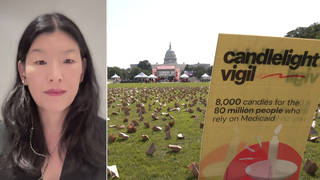
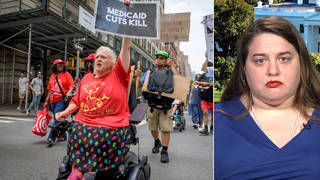
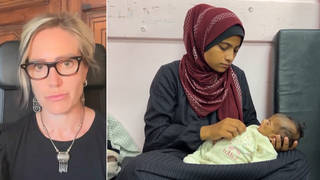
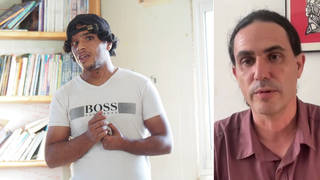
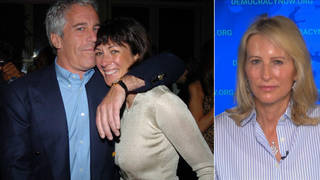
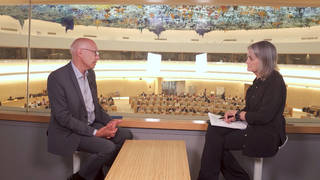
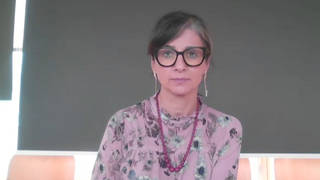




Media Options